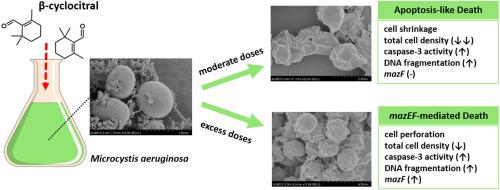当前位置:
X-MOL 学术
›
Environ. Pollut.
›
论文详情
Our official English website, www.x-mol.net, welcomes your feedback! (Note: you will need to create a separate account there.)
β-cyclocitral induced rapid cell death of Microcystis aeruginosa
Environmental Pollution ( IF 8.9 ) Pub Date : 2024-03-19 , DOI: 10.1016/j.envpol.2024.123824 Xuejian Wang , Huansheng Cao , Yinjie Zhu , Tingru Zhou , Fei Teng , Yi Tao
Environmental Pollution ( IF 8.9 ) Pub Date : 2024-03-19 , DOI: 10.1016/j.envpol.2024.123824 Xuejian Wang , Huansheng Cao , Yinjie Zhu , Tingru Zhou , Fei Teng , Yi Tao

|
β-cyclocitral (BCC) is an odorous compound that can be produced by bloom-forming cyanobacteria, for example, . BCC has been proposed to explain the rapid decline of cyanobacterial blooms in natural water bodies due to its lytic effects on cyanobacteria cells. However, few insights have been gained regarding the mechanisms of its lethality on cyanobacteria. In this study, was exposed to 0–300 mg/L BCC, and the physiological responses were comprehensively studied at the cellular, molecular, and transcriptomic levels. The result indicated that the lethal effect was concentration-dependent; 100 mg/L BCC only caused recoverable stress, while 150–300 mg/L BCC caused rapid rupture of cyanobacterial cells. Scanning electron microscope images suggested two typical morphological changes exposed to above 150 mg/LBCC: wrinkled/shrank with limited holes on the surface at 150 and 200 mg/L BCC exposure; no apparent shrinkage at the surface but with cell perforation at 250 and 300 mg/L BCC exposure. BCC can rapidly inhibit the photosynthetic activity of cells (40%∼100% decreases for 100–300 mg/L BCC) and significantly down-regulate photosynthetic system Ⅰ-related genes. Also, chlorophyll (by 30%∼90%) and ATP (by ∼80%) contents severely decreased, suggesting overwhelming pressure on the energy metabolism in cells. Glutathione levels increased significantly, and stress response-related genes were upregulated, indicating the perturbation of intracellular redox homeostasis. Two cell death pathways were proposed to explain the lethal effect: apoptosis-like death as revealed by the upregulation of SOS response genes when exposed to 200 mg/L BCC and -mediated death as revealed by the upregulation of system genes when exposed to 300 mg/L BCC. Results of the current work not only provide insights into the potential role of BCC in inducing programmed cell death during bloom demise but also indicate the potential of using BCC for harmful algal control.
中文翻译:

β-环柠檬醛诱导铜绿微囊藻快速细胞死亡
β-环柠檬醛 (BCC) 是一种有气味的化合物,可由形成水华的蓝细菌产生,例如。 BCC 已被提出来解释天然水体中蓝藻水华由于其对蓝藻细胞的溶解作用而迅速减少。然而,关于其对蓝藻的致死机制却知之甚少。在这项研究中,暴露于0-300 mg/L BCC,并在细胞、分子和转录组水平上全面研究了其生理反应。结果表明,致死作用具有浓度依赖性; 100 mg/L BCC仅引起可恢复应力,而150~300 mg/L BCC则引起蓝藻细胞快速破裂。扫描电子显微镜图像表明,暴露于 150 mg/L 以上的 LBCC 时会出现两种典型的形态变化:暴露于 150 和 200 mg/L BCC 时,表面起皱/收缩,且有有限的孔洞;在 250 和 300 mg/L BCC 暴露下,表面没有明显收缩,但细胞穿孔。 BCC能迅速抑制细胞的光合活性(100~300 mg/L BCC可降低40%~100%),并显着下调光合系统Ⅰ相关基因。此外,叶绿素(下降30%~90%)和ATP(下降~80%)含量严重下降,表明细胞能量代谢面临巨大压力。谷胱甘肽水平显着增加,应激反应相关基因上调,表明细胞内氧化还原稳态受到干扰。提出了两种细胞死亡途径来解释致死效应:暴露于 200 mg/L BCC 时 SOS 反应基因上调所揭示的凋亡样死亡,以及暴露于 300 mg/L BCC 时系统基因上调所揭示的介导死亡/L 密件抄送。目前的工作结果不仅深入了解了 BCC 在水华消亡过程中诱导程序性细胞死亡的潜在作用,而且还表明了使用 BCC 控制有害藻类的潜力。
更新日期:2024-03-19
中文翻译:

β-环柠檬醛诱导铜绿微囊藻快速细胞死亡
β-环柠檬醛 (BCC) 是一种有气味的化合物,可由形成水华的蓝细菌产生,例如。 BCC 已被提出来解释天然水体中蓝藻水华由于其对蓝藻细胞的溶解作用而迅速减少。然而,关于其对蓝藻的致死机制却知之甚少。在这项研究中,暴露于0-300 mg/L BCC,并在细胞、分子和转录组水平上全面研究了其生理反应。结果表明,致死作用具有浓度依赖性; 100 mg/L BCC仅引起可恢复应力,而150~300 mg/L BCC则引起蓝藻细胞快速破裂。扫描电子显微镜图像表明,暴露于 150 mg/L 以上的 LBCC 时会出现两种典型的形态变化:暴露于 150 和 200 mg/L BCC 时,表面起皱/收缩,且有有限的孔洞;在 250 和 300 mg/L BCC 暴露下,表面没有明显收缩,但细胞穿孔。 BCC能迅速抑制细胞的光合活性(100~300 mg/L BCC可降低40%~100%),并显着下调光合系统Ⅰ相关基因。此外,叶绿素(下降30%~90%)和ATP(下降~80%)含量严重下降,表明细胞能量代谢面临巨大压力。谷胱甘肽水平显着增加,应激反应相关基因上调,表明细胞内氧化还原稳态受到干扰。提出了两种细胞死亡途径来解释致死效应:暴露于 200 mg/L BCC 时 SOS 反应基因上调所揭示的凋亡样死亡,以及暴露于 300 mg/L BCC 时系统基因上调所揭示的介导死亡/L 密件抄送。目前的工作结果不仅深入了解了 BCC 在水华消亡过程中诱导程序性细胞死亡的潜在作用,而且还表明了使用 BCC 控制有害藻类的潜力。



























 京公网安备 11010802027423号
京公网安备 11010802027423号